
GOVERNMENT
MACHINERY OF GOVERNMENT
Separation of Powers
The Constitution established three main branches of government – executive, legislative, judicial – that are separate and distinct from one another. The three branches must work together and at the same time can counteract one another to ensure that no one branch gains too much power.
Legislative Branch: Congress
P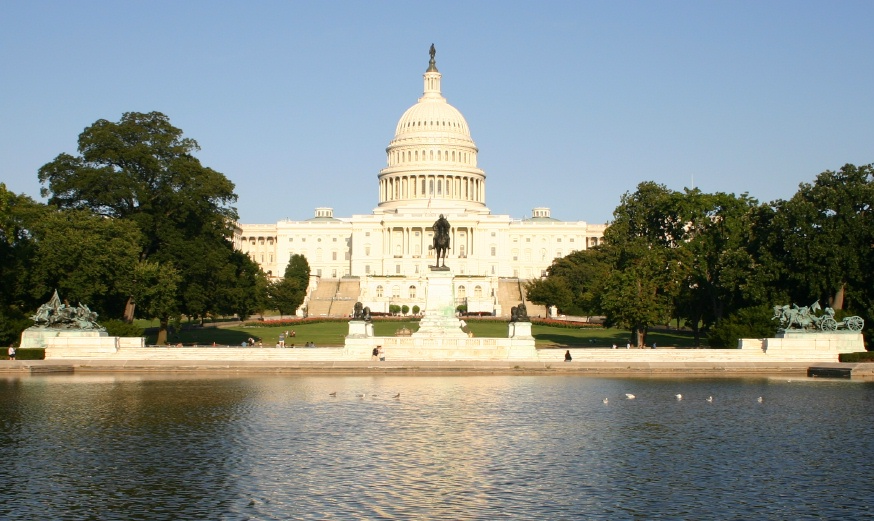 hoto:
Capitol, Washington, D.C. The legislative branch
- Congress - consists of the Senate (the upper chamber), and the
House of Representatives (the lower chamber). All in all, 100
Senators and 435 members of the House of Representatives (commonly
referred to as Congressmen), sit in Congress. The seat of American
Congress is the Capitol building, located in Washington, D.C., on top
of Capitol Hill.
hoto:
Capitol, Washington, D.C. The legislative branch
- Congress - consists of the Senate (the upper chamber), and the
House of Representatives (the lower chamber). All in all, 100
Senators and 435 members of the House of Representatives (commonly
referred to as Congressmen), sit in Congress. The seat of American
Congress is the Capitol building, located in Washington, D.C., on top
of Capitol Hill.
The Senate is composed of two members from each state, regardless of the state’s size. The duty of the Senate is to ensure that all states are treated equally and the interests of the smaller states are taken into account along with the interests of the bigger ones.
Unlike the Senate, representation in the House of Representatives is directly proportional to the population of the state. The more populous the state is, the more members in the House of Representatives it has. Every state is constitutionally guaranteed at least one member of the House. Currently, seven states have only one representative. On the other hand, four states have more than 20 representatives - California has 53, Texas – 32, New York – 29, Florida - 25. Under the Constitution, a national census should be held every 10 years, after which the House seats are redistributed according to population shifts.
Powers of Congress are defined by the Constitution, but none of them is more important than the power to make laws. Any senator or congressman may introduce a bill, after which it is referred to the appropriate legislative committee for hearings. The committee, in turn, debates the bill, possibly offering amendments, then votes on it. If approved, the bill heads back to the chamber from which it came, where the full body will vote on it. If lawmakers approve the measure, it will be sent to the other chamber for a vote, and when both chambers have approved it, it is ready for the President. The President may either sign a bill into law or veto it. Congress, in turn, has the power to override a presidential veto with a two-thirds majority in both chambers.
In addition, Congress has the power to amend the Constitution, to declare war, to collect taxes, to investigate pressing national issues and many others, which are spelled out in the U.S. Constitution.
Executive Branch: President and their Administration
The Executive power lies with the President of the United States, who is responsible for enforcing the laws of the land. The executive branch of the U.S. government includes the President, the Vice President, 15 Executive Departments and over 50 Independent Agencies. The President is the leader of the country and Commander in Chief of the military. The Vice President is President of the Senate and also the one who becomes President if the President is unable to serve. The Executive Departments advise the President on policy issues and help execute those policies. The Independent Agencies help execute policy or provide special services. Among the most important independent agencies are the Federal Reserve System, Federal Trade Commission, Central Intelligence Agency, National Aeronautics and Space Administration (NACA) and others.
The President and the Vice-President are the only officials elected by the entire country. However, there are requirements for holding either of these positions. The presidential candidate must be at least 35 years old. Also, each candidate must be a natural-born U.S. citizen and have lived in the U.S. for at least 14 years. Recently, there has been some debate about whether presidents must be natural-born citizens. Because the U.S. is a nation of immigrants, many people argue that all citizens should have the opportunity to become president. The election of Arnold Schwarzenegger as California governor brought forward this debate again.
President’s tenure of office is limited to two terms. The first president, George Washington served only two terms and a two-term limit for presidents became traditional. It remained the standard for 150 years, avoiding the election of a “constitutional monarch”, a perpetually re-elected tyrant. In the 1930-1940s, however, Franklin D. Roosevelt ran successfully in four elections as Americans fought first the Great Depression and then World War II. Despite Roosevelt’s popularity, negative reaction to his long tenure in office ultimately led to passage of the Twenty-Second Amendment, which limited presidents to two four-year terms.
P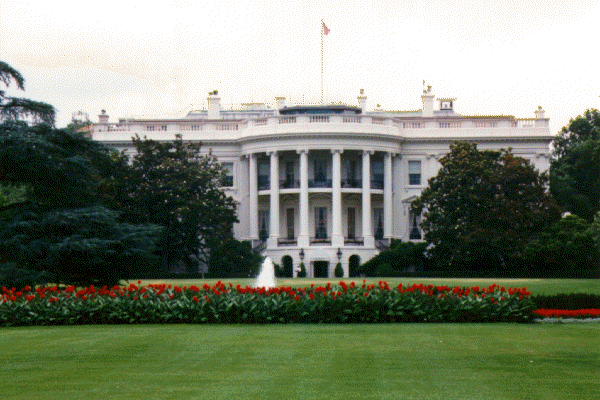 hoto:
White House, Washington, D.C.
The office of President of the U.S is one of the most powerful in
the world. The chief duty of the President is to enforce the laws
made by the Congress. But, of course, the range of presidential
powers is much broader than that. The president has the power to
recommend legislation to the Congress, to sign or veto legislation,
to appoint federal judges, to appoint heads of federal departments
and agencies; to appoint representatives to foreign countries and to
carry on official business with foreign nations; to grant pardons for
offences against the U.S. The President is also the official head of
the U.S. military forces. As Commander in Chief, he can authorize the
use of troops overseas without declaring war. To declare war
officially, though, he must get the approval of the Congress.
hoto:
White House, Washington, D.C.
The office of President of the U.S is one of the most powerful in
the world. The chief duty of the President is to enforce the laws
made by the Congress. But, of course, the range of presidential
powers is much broader than that. The president has the power to
recommend legislation to the Congress, to sign or veto legislation,
to appoint federal judges, to appoint heads of federal departments
and agencies; to appoint representatives to foreign countries and to
carry on official business with foreign nations; to grant pardons for
offences against the U.S. The President is also the official head of
the U.S. military forces. As Commander in Chief, he can authorize the
use of troops overseas without declaring war. To declare war
officially, though, he must get the approval of the Congress.
The Vice President of the United States is the first person in the presidential line of succession, becoming the new President of the nation upon the death, resignation, or removal of the president. The vice president also serves as the President of the Senate, and may break tie votes in that chamber (In modern times, the vice president rarely presides over day-to-day matters in the Senate; in his place, the Senate chooses a President pro tempore (or "president for a time") to preside in the Vice President's absence).
To carry out the President’s responsibilities, the President presides over a vast organization numbering several million people, who work at the government departments and agencies. Of the 15 departments currently in existence, the oldest (established at the time of the ratification of the U.S. Constitution in 1789) are the Department of State, the Department of the Treasury and the Department of War (now called the Department of Defense). The latest-established department is the Department of Homeland Security created by President George W. Bush in response to the 9/11 terrorist attacks on the United States. All departments are headed by the Secretaries who are nominated by the President and confirmed (or rejected) by the Senate.
The heads of the major Departments – their Secretaries - make up the Cabinet. The Cabinet is an informal institution which has no basis in the Constitution. It is based on practice and precedent and its existence dates back to the first American President George Washington, who appointed a Cabinet of four people to advise and assist him in his duties. They were the Secretary of State, the Secretary of the Treasury, the Secretary of War, and the Attorney General. From that time on, the Secretaries of these four Departments have become the most powerful and relevant Cabinet members. In recent years, the Secretary of Homeland Security has risen to a level of significance close to the “big four”. Presidents today also include their vice presidents in Cabinet meetings, as well as any other agency heads or officials to whom they would like to give Cabinet-level status. But although the Cabinet is still an important organ of bureaucratic management, it has been generally declining in relevance as a policy making body. Starting with President Franklin Roosevelt, the trend has been for the presidents to act through the Executive Office of the President or the National Security Council rather than through the Cabinet. This has created a situation in which non-cabinet officials such as the White House Chief of Staff or the National Security Advisor are now as powerful or more powerful than some Cabinet officials.
J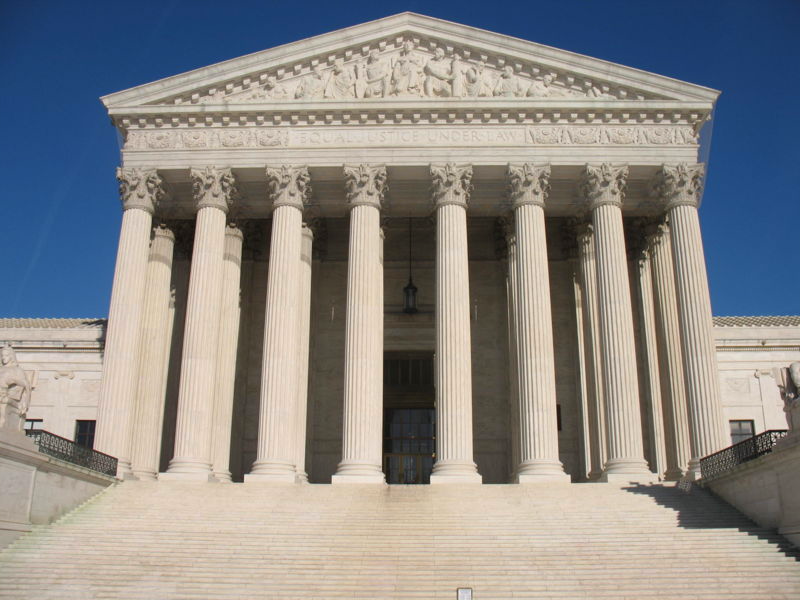 udicial
Branch: the Supreme Court and the System of Lower Courts
udicial
Branch: the Supreme Court and the System of Lower Courts
The judicial power of the United States is vested in the Supreme Court and the federal courts. The judiciary consists of a three-tiered system of courts, headed by the Supreme Court of the U.S. The Constitution protects independence of the federal judges by providing that they are appointed for life, or, as is said in the Constitution, “during good behavior.” If a judge commits an offence, he may be removed from office, but only after being impeached.
Photo: Supreme Court Building, Washington, D.C.
At the bottom of the U.S. federal judiciary are the federal district courts. The 50 states and U.S. territories are divided into 94 districts so that litigants may have a trial within easy reach. Cases are heard in district courts when they involve federal offenses such as theft of federal property, violations of pure-food, banking and counterfeiting laws, bankruptcy and civil suits between citizens of different states if the amount in issue is more than $75,000.
The second highest level of the federal judiciary is made up of 13 courts of appeals which review decisions of the federal courts. They were created to ease the burden on the Supreme Court.
The highest court of the land is the Supreme Court. It is the final court of appeal placed at the top of the judicial pyramid. Most importantly, the Supreme Court acts as the final interpreter of the U.S. Constitution and has the power to determine whether a law or an executive act is constitutional or not. If the Supreme Court strikes down the law as unconstitutional, the law becomes null and void. This function of the Supreme Court is called the power of judicial review.
T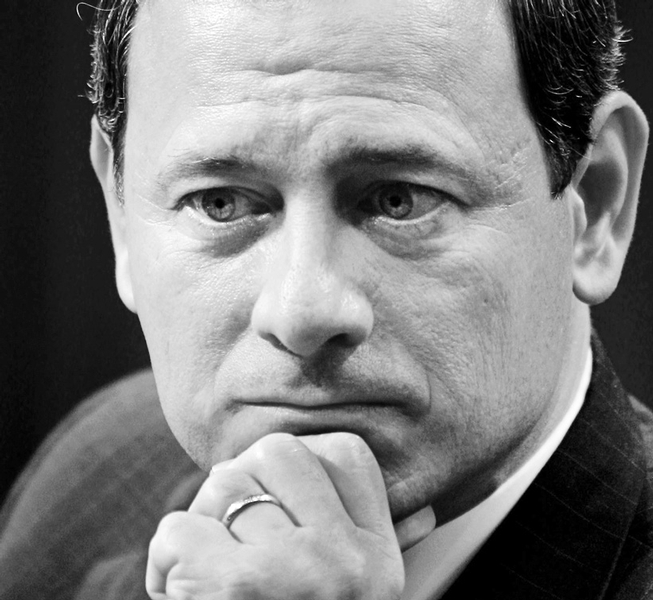 he
Supreme Court consists of nine justices: the Chief Justice of the
U.S. and eight associate justices. Like all federal judges, the
justices of the Supreme Court are nominated by the president and
confirmed by the Senate, and they retain their office indefinitely
during “good behavior” (so far not a single Supreme Court justice
has been impeached). Since the Supreme Court justices hold their
jobs for life, the newly-elected presidents don’t appoint all the
judges on the bench, but only fill the opening vacancies. George W.
Bush, for instance, filled two vacancies in the Supreme Court that
opened upon the retirement of one justice and death of the other. Of
the rest of the current justices, one was appointed by President G.
Ford, two - by President R. Reagan, two - by President G. Bush, and
two - by W. Clinton.
he
Supreme Court consists of nine justices: the Chief Justice of the
U.S. and eight associate justices. Like all federal judges, the
justices of the Supreme Court are nominated by the president and
confirmed by the Senate, and they retain their office indefinitely
during “good behavior” (so far not a single Supreme Court justice
has been impeached). Since the Supreme Court justices hold their
jobs for life, the newly-elected presidents don’t appoint all the
judges on the bench, but only fill the opening vacancies. George W.
Bush, for instance, filled two vacancies in the Supreme Court that
opened upon the retirement of one justice and death of the other. Of
the rest of the current justices, one was appointed by President G.
Ford, two - by President R. Reagan, two - by President G. Bush, and
two - by W. Clinton.
Photo: Current Chief Justice of the U.S. John G. Roberts
Some rulings of the Supreme Court are particularly important. These rulings, known as landmark decisions or landmark cases, establish legal precedents and substantially change the interpretation of the law. They receive a lot of publicity and become known to many people, not only lawyers and legal scholars. Miranda v. Arizona is one of the recent landmark cases.
Because the Supreme Court has the final word on the meaning of the Constitution, it has acquired a tremendous policy-making power. Many groups, who cannot achieve policy change through traditional legislation, choose to bring their claims to the federal courts, so that they could reach on appeal the Supreme Court and thus take their struggle into the national spotlight.
Over the years, the Supreme Court has gradually achieved an almost hallowed status. It has acquired an extraordinary power to decide societal disputes, interpret the national constitution, and make public policy. One of the most frequently cited cases to demonstrate it is the Court's pronouncement of the victor in the 2000 presidential election. The 2000 presidential contest was one of the most closely divided - and confusing - elections in American history. A month after voters cast their ballots it still was not clear who would become the nation's 43rd president. The deciding votes were cast in the state of Florida, and long after Election Day ended, questions were raised about whether some of Florida's ballots had not been counted because of mechanical errors, and about what should be done if that was the case. Heated speeches were made in the U.S. Congress. Partisans of both candidates, George W. Bush and Al Gore, demonstrated in Florida and throughout the nation in support of their candidates. While the controversy raged, a case about it was brought before the U. S. Supreme Court. The decision by the Court effectively declared Bush the victor over Gore. And that was that. Gore made a speech congratulating Bush. The demonstrators went home. Politicians went on television to declare that it was now time to join forces and get on with the country's business. Not everyone was happy with the court's decision, but there was near-unanimity that it had to be accepted.
Federalism
Photo: Arnold Schwarzenegger, Current CA Governor
A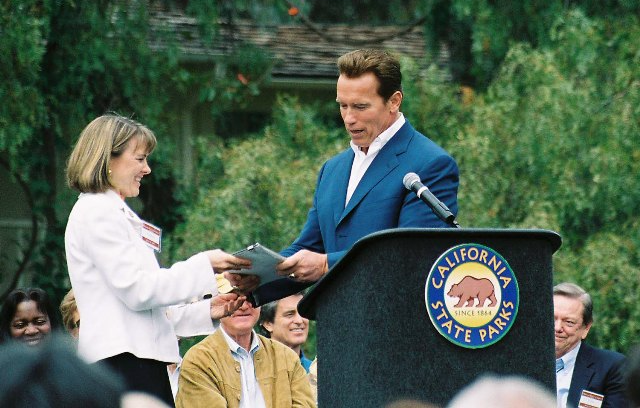 merican
Constitution was very much a reaction to the events that came before
it – the struggle of 13 American colonies for independence. The
Founding Fathers had several goals in mind, foremost among which was
to avoid tyranny. In order to prevent the abuse of power, two
different systems were set up – federalism and the system of checks
and balances.
merican
Constitution was very much a reaction to the events that came before
it – the struggle of 13 American colonies for independence. The
Founding Fathers had several goals in mind, foremost among which was
to avoid tyranny. In order to prevent the abuse of power, two
different systems were set up – federalism and the system of checks
and balances.
Federalism was designed to balance the power between the Federal and State governments and thus limit the powers of the national government. Jefferson and others were convinced that state government was closer to the people and thus more democratic.
In the American federal system, the national (federal) government has certain powers that are granted only to it by the Constitution. The 50 state governments also have powers that the national government is not supposed to exercise. For example, only the federal government may coin money or declare war. But only the state government may establish local governments and conduct elections within the state. Some powers are shared by both federal and state governments, such as the power to tax and borrow money. Some powers are denied to both governments, for example, the power to grant titles of nobility.
State Constitutions
The state was the basic, original unit of government in America. The constitutions of the states were written and adopted before the Constitution of the U.S. In contrast to the U.S. Constitution, state constitutions are relatively easy to amend. As a result, 31 states have adopted wholly new constitutions since they were first admitted into the Union, and almost 6,000 specific amendments to the state constitutions have been adopted. Another effect of the easy amendment process is that state constitutions tend to be long and include minor administrative rules. The California constitution, for example, defines how long a wrestling match may be, and Arkansas included in its constitution what colours should be used for copies of registration documents.
Unlike the U.S. Constitution, which was to empower the national government, the original state constitutions wanted to limit government. They provided for the state legislatures, executives and courts with an emphasis on limiting the authority of each institution. In the past, state governments were part-time governments and people in office were farmers, teachers, lawyers and shop owners who did public service during their spare time. With time, however, as the responsibilities and challenges of government grew, more state officials became full-time. In the 1960s and 1970s, the importance of state and local governments was enhanced and they are becoming increasingly important today.
State Legislatures, Executives and Courts
All U.S. states have a state constitution and a three-branch government similar to that of the federal government. While the U.S. Constitution requires each state to have a "republican form" of government, its particular structure varies from state to state.
49 states have bicameral legislatures with two legislative houses. One, the senate, typically has fewer members than the other, usually called the “house” or the “assembly”. The exception to this rule is Nebraska, which has one house (a unicameral legislature). The majority of state legislatures meet every year, and only seven meet once in two years. The recent development for the legislators in some states was the introduction of term limits: the number of years one might be a state legislator is limited to between 6 and 12 years. This is done to give more people a chance to participate in legislatures and also to ensure that people serve as legislators in addition to whatever else they do in life, as opposed to pursuing a career as an elected official. State legislatures today are still primarily part-time, citizen bodies.
As each state is free to organize its government in any way it likes, there has been a great diversity of each state’s executive departments and agencies, but every state’s executive branch is headed by an elected governor. Today governors play the most important roles in the state governments. When they campaign for office, they identify the most pressing problems facing their states and propose solutions to these problems. Most importantly, governors draw up state budgets, which are critical to the business of state governments. Like presidents, governors have a power of veto and can approve or reject a bill submitted by the state legislature. Executive responsibilities of the governor cover education, public health, transportation, and economic development, so the governor’s job is also to oversee the work of the agencies that implement the state laws in these spheres.
The state judicial branch is a three-level pyramid typically headed by a state supreme court. At the bottom of the system are state trial courts, who hear about 100 million cases a year. If parties to a legal case are not satisfied with the ruling of a trial court, they may file an appeal to a state intermediate appellate court and then – to a state supreme court.
The System of Checks and Balances
Not only does each branch of American government have particular powers, but each branch has certain powers over the other branches – it has the power to check and balance them (hence the name - the system of checks and balances). For example:
Congress may pass laws........but the President can veto them.
The President can veto laws.......but Congress can override the veto with a 2/3 vote.
The President and Congress may agree on a law..........but the Supreme Court can declare a law unconstitutional.
The President can appoint Judges and other government officials.......but Senate must approve them.
Justices of the Supreme Court have life terms.......but they can be impeached by Congress.
These are but a few ways (there are many more than listed), in which the Constitution balances power. These checks and balances are used on a regular basis. Real life conflicts that test the system have occurred throughout history. After the Civil War, President Andrew Johnson vetoed over 20 bills. In 1918, Congress refused to ratify the Treaty of Versailles, a peace treaty ending World War I that President Wilson had worked very hard on. In 1930s, the Supreme Court declared two economic programs by the Roosevelt administration unconstitutional. In 1987, when President Reagan appointed Judge R. Bork to the Supreme Court, his nomination was defeated. There are thousands of other examples of checks and balances at work.
R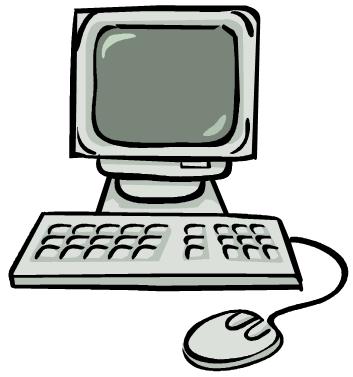 esearch
Incentive: use
the Internet to answer trivia questions.
esearch
Incentive: use
the Internet to answer trivia questions.
What are the posts of the presiding officers in the Senate and in the House of Representatives called? What people do currently hold these positions?
What is “pocket veto” and who introduced it?
There is a “federal city” in America, whose residents sometimes refer to themselves as the “last colony” because they are the only residents of the United States who do not have voting representation in Congress, yet they pay federal income taxes just like anybody else. City officials even added the slogan “Taxation without Representation” to their license plates. What is this city?
Active vocabulary
Check the pronunciation and the Russian translation of the words and expressions;
reproduce the context in which they are used in the text.
regardless of to be directly proportional to to hold a national census
to sign a bill into law to veto a bill to override a presidential veto
to be vested in tenure of office presidential powers to authorize smth.
to break a tie vote to preside over smth. 9/11 terrorist attacks government body three-tiered system to commit an offence abuse of power
become null and void partisans of candidates to draw up a budget
Vocabulary study:
1. Check the pronunciation: “chamber”,” Senate”, “senators”, “tyrant”, “Franklin D. Roosevelt”, “attorney”, “Arkansas”.
2. Use a dictionary to find synonyms to “to sign a bill into law”.
3. Use a dictionary to find derivatives of “partisan”. Translate them into Russian.
4. What is the difference between “judges”, “justices” and “judges on the bench”?
5. What is the difference between a “bill” and a “law”?
6. Find in the text two expressions that mean “власть принадлежит”
C![]() omprehension
check:
omprehension
check:
Define the concepts: “separation of powers”, “a tie vote”, “power of judicial review”, “landmark decision”, “federalism”, “checks and balances”
Answer the questions on the text.
What is the make-up and the functions of the legislative branch?
How does a bill become a law?
What is the composition and powers of the executive branch?
What are qualifications for being President of the U.S.?
How does a system of federal courts function?
What court enjoys an almost “hallowed status”? Why?
How do the state constitutions differ from the U.S. Constitution?
What makes the states’ legislatures, executives and judiciaries?
How do the three branches of government check and balance each other?
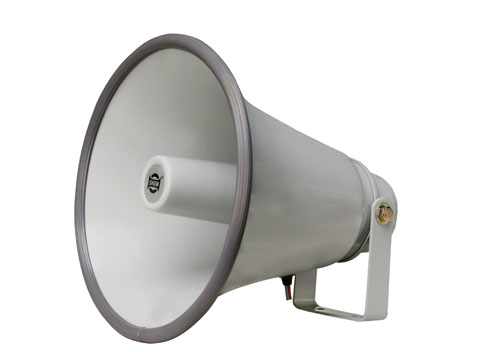
Public speaking skills: present a mini report on one of the following topics.
Filibustering
Lobbyism
When Checks and Balances Failed …

Interaction: role-play the following
Role Play: How a Bill Becomes a Law
Role A, B, C: The Legislative Branch
You are Congressmen (the Speaker of the House, Senate Majority Leader and Senate Minority Leader), writing a bill that restricts the content of what can be put on the World Wide Web. It must be a proposed law that makes it a crime to publish on the Internet any criticism of the president or his advisors. List the main points of the bill you propose. The final results of the bill discussion must be that it is passed and is sent to the President for approval. If the president vetoes the bill, the Congress will make amendments to the bill and resubmit the changed bill to the President.
Role D, E: The Executive Branch
The roles include the President and Vice President. You will have to decide if the bill should be approved by the President or vetoed. Vice President must write a "memorandum" to the president stating his or her position on the bill with a recommendation to the president whether or not it should be vetoed. List the reasons for and against such a bill.
Role F, G, H: The Print and Electronic Media
You are the CEOs of the most influential Media Holdings in the country. If the bill becomes law, the Media (TV, Radio, Newspapers, and Magazines) must be ready to sue the federal government on the basis of the First Amendment Freedoms of press and speech. The Press will learn of the President's decision at a press conference. They must have questions ready for the President no matter which way he decides: for or against the bill. Members of the media must write one or more editorials opposing (and supporting, even though this position would be in the minority) the bill.
Role J, K, L: The Judicial Branch
You are Supreme Court Justices. The Supreme Court must be ready to ask the Congress questions about the bill in order to learn facts that will lead to a decision in a lawsuit brought by the Press against the bill. The Supreme Court must develop five to seven questions it can ask lawyers on both sides. The Supreme Court will also have to vote on the constitutionality of the bill. Those in favour and those opposed to the bill must write a "majority" and "minority" opinion in the case.
Self-Check Translate using active vocabulary:
В то время как в Сенат делегируются по два представителя от каждого штата независимо от численности населения, количество конгрессменов в Палате представителей прямо пропорционально населению штатов. Поэтому Конституция предусматривает проведение национальной переписи населения раз в десять лет.
Исполнительная власть принадлежит президенту. Президент может либо утвердить законопроект, либо наложить на него вето. Преодолеть президентское вето Конгресс может двумя третями голосов. Это – один из примеров того, как система сдержек и противовесов препятствует злоупотреблению властью.
Президент Трумэн воспользовался своими широкими президентскими полномочиями не только для составления национального бюджета, но и для санкционирования применения ядерного оружия.
Состав органов власти, сроки полномочий высших должностных лиц, так же как и круг их полномочий, определены Конституцией.
Вице президент председательствует в Сенате и может помочь преодолеть равенство голосов при голосовании.
Возглавляет трёхуровневую систему федеральных судов Верховный Суд, судьи которого могут объявить любой закон неконституционным, и тогда он утратит юридическую силу. Но если какой-нибудь судья совершит проступок, он может быть отстранён от должности в результате импичмента.
После терактов 11 сентября сторонники обеих партий в Конгрессе проголосовали за создание нового правительственного органа – Департамента национальной безопасности.
Complete the chart:
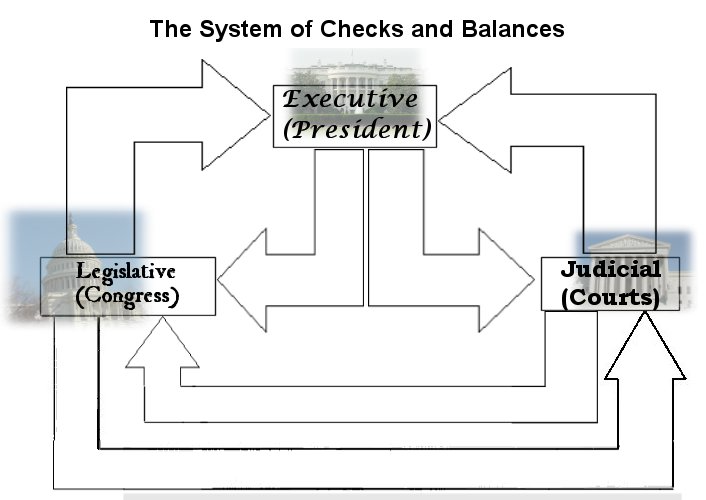
“You Have the Right to Remain Silent…”
